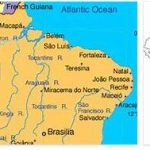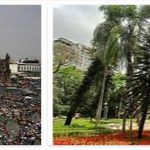The country of Brazil got its name from a type of tree, the brazilwood tree, the wood of which is deep red and is called brasil (“glowing red”)by the natives. Today this tree species is almost extinct because it was a sought-after import in Europe.
Location
The Republic of Brazil is almost as big as all of Europe, making it the fifth largest country in the world. It is the largest of the countries in South America and has an area of over 8.5 million square kilometers. Brazil shares borders with all South American countries except Chile and Ecuador.
Time zone
Compared to our German time, Brazil is 4 hours behind in winter and 5 hours in summer.
Business
Brazil’s economy is in the production of coffee, citrus fruits, and soybeansleading. The production of beer is also of great importance, here it ranks fourth in the global ranking. Other important branches of the economy are automobile manufacture and the steel, iron and aluminum industries. The rich mineral resources, the good quality of iron ore, crude oil and natural gas have made Brazil an industrial country. Nevertheless, Brazil is a country with numerous economic problems: corruption is widespread and the unequal distribution of property in land repeatedly causes uprisings. 80% of the usable area falls on holdings that are larger than 100 ha, and that is only 10% of all holdings. The families become impoverished and have to sell their land to the big landowners. There are already 5 million families who have lost their land in this way and are organizing a movement.
Due to the political instability of Brazil, a continuous economic policy was not possible either. The actually rich country became impoverished. Today the government is trying to support the poorest sections of the population through state projects and to revive the economy. In addition to the South American countries, the USA, Europe and the People’s Republic of China are important trading partners.
Memberships
Brazil is a founding member of the United Nations, the World Bank, the International Monetary Fund (IMF), the Organization of American States and the Association of South American States (MERCOSUL).
Population
Brazil has 191 million residents, 50% of which are whites, 40% of mixed race (mainly with Portuguese) and descendants of the 4 million slaves who were brought to the plantations from Africa. By the end of the 19th century, many Germans and Italians also came to the country, and in the 20th century also Poles and other Eastern Europeans. Even Arabs and Japanese settled in Brazil. The greatest concentration of the population is found in the cities. Most of the rural refugees are so poor that they can only find shelter in the favelas, the slums on the outskirts of the city.
The 300,000 members of the indigenous Indian tribes live mainly in the Amazonia.
Samba
The name of the most famous music genre in Brazil comes from the Congolese word semba, which means “to dance”. It was formed from the round dances of the slaves mixed with a variation of the Polish polka.
Religion
Officially around 75% of Brazilians are Catholic, but the number of followers of African and Indian beliefs is increasing year by year, especially in the cities. The Macumba cult is most widespread here. It combines African elements from the Bantu tradition with Christian, spiritual and occult elements and is led by a Macumbeiro (medicine man). 10% of the population profess the Protestant religion.
Language
In contrast to the other South American countries, the official language is not Spanish, but Portuguese, even if it is spoken more softly than in the former mother country. English is only spoken in typical tourist centers.
Food and drink
The most traditional side dishes in Brazil are rice and beans, but often you won’t find any side dishes in Brazil either. A Brazilian specialty is “ churrasco ”, which consists of different types of meat on skewers. The guest can then choose which piece of meat they would like to eat and get it cut straight off the skewer. Another typical dish is “ feijoada ”, a stew made from very fatty meats and sausages, bacon and beans.
Most people in Brazil drink beer. Caipirinha, on the other hand, are almost always only consumed by tourists, whereas Brazilians prefer to drink sugar cane schnapps straight. Otherwise there are many fruit juice stands in Brazil where you can enjoy delicious and, above all, fresh juices made from all kinds of fruits.
Entry
Entering Brazil is not complicated. A so-called entry or exit card, the cartao de entrada / saida, which is usually distributed during the flight, must be filled out. Even if the presentation of the card is no longer required at passport control, according to official information, you must always be able to show it. The passport should be valid for at least 180 days upon entry. Children’s IDs should contain a passport photo, regardless of the age of the child. Visit shoe-wiki for Brazil Travel Guide.
Medical advice
The current n information, please contact your family doctor or respectively. you can see it on the website of the Center for Travel Medicine (CRM).
Current
Brazil has a power supply of 220 V, but as the sockets can vary, it is advisable to bring an international adapter with you to be on the safe side.
Security / drugs
Brazil is a relatively safe country. Visiting the slums is, however, strongly discouraged. The Federal Foreign Office offers current information on the security situation in Brazil on its website https://www.auswaertiges-amt.de/.
Since drug offenses are severely punished in Brazil, any contact with drugs should be avoided.
It should also “topless” bathing and changing clothes in public to be avoided at all costs, as this public and indecency applies and can lead to arrests.
Addresses
In Germany:
Embassy of the Federal Republic of Brazil
Wallstr. 57
170179 Berlin
E-Mail: brasil@brasemberlim.de
https://berlim.itamaraty.gov.br/de/
Consulates general in Frankfurt am Main, Munich, Aachen, Bremen, Hanover, Heidelberg, Stuttgart
The exact addresses and opening times can be found at www.auswaertiges-amt.de/
In Brasil
Embassy of the FRG
Avenida das Nações, Lot 25, Quadra 807,
70415-900 Brasilia DF E-Mail: info@brasilia.diplo.de
Foreign Office
In Germany https://www.auswaertiges-amt.de/
In Austria https://www.bmaa.gv.at/
In Switzerland https://www.eda.admin.ch/
Frequently asked questions about Brazil
What are the entry requirements for Brazil?
For stays that do not last longer than 90 days, German citizens need a passport that is valid for at least 6 months when entering Brazil.
What vaccinations do you need to travel to Brazil?
No evidence of yellow fever vaccination is required when entering Brazil. However, it is recommended that all travelers get vaccinations before traveling to an area in Brazil with yellow fever. In addition, vaccination against tetanus, diphtheria, whooping cough and hepatitis A is recommended for all travelers, and against hepatitis B, rabies and typhoid for long-term stays of over four weeks. We urgently recommend taking out health insurance abroad, which should include repatriation.





